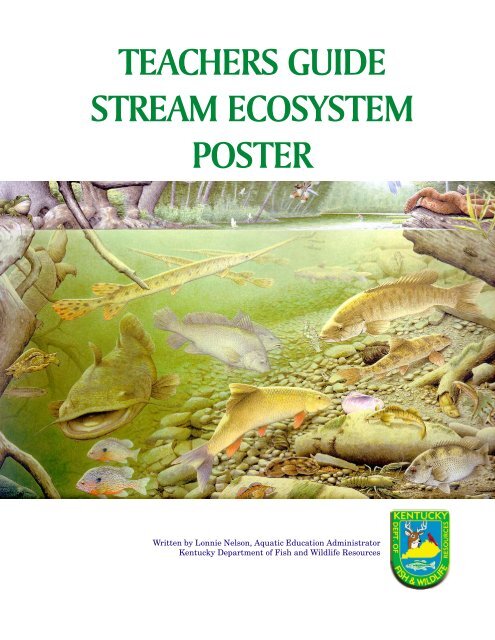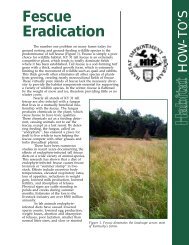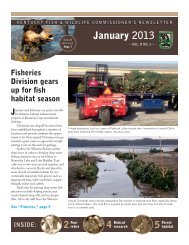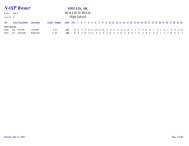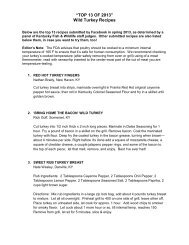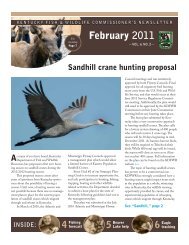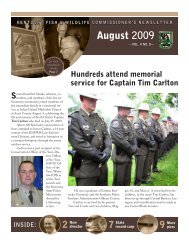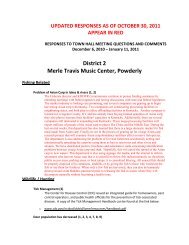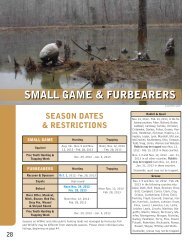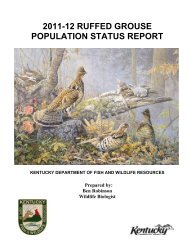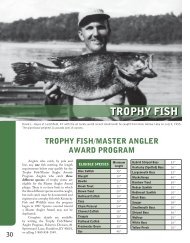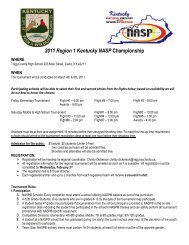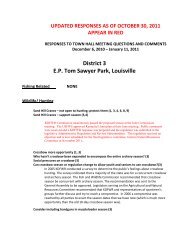stream poster TG.p65 - Kentucky Department of Fish and Wildlife ...
stream poster TG.p65 - Kentucky Department of Fish and Wildlife ...
stream poster TG.p65 - Kentucky Department of Fish and Wildlife ...
Create successful ePaper yourself
Turn your PDF publications into a flip-book with our unique Google optimized e-Paper software.
TEACHERS GUIDE<br />
Notes<br />
STREAM ECOSYSTEM<br />
POSTER<br />
Written by Lonnie Nelson, Aquatic Education Administrator<br />
<strong>Kentucky</strong> <strong>Department</strong> <strong>of</strong> <strong>Fish</strong> <strong>and</strong> <strong>Wildlife</strong> Resources<br />
1
2<br />
Notes<br />
INTRODUCTION<br />
Welcome to the aquatic world <strong>of</strong> Rick Hill, artist for the <strong>Kentucky</strong> <strong>Department</strong> <strong>of</strong> <strong>Fish</strong><br />
<strong>and</strong> <strong>Wildlife</strong> Resources. Having watched the development <strong>of</strong> this <strong>poster</strong> from its inception,<br />
I recommend you either hold your breath or use a snorkel!<br />
The Stream Ecosystem <strong>poster</strong> represents a typical middle order (sixth to seventh<br />
order) <strong>stream</strong>. (When water first trickles into a running <strong>stream</strong> it is called a first order<br />
<strong>stream</strong>. When two first order <strong>stream</strong>s join they become a second order <strong>stream</strong>. When two<br />
second order <strong>stream</strong>s join they become a third order <strong>stream</strong>, etc. The largest order river<br />
in the United States is the Mississippi, a twelfth order river.) Species selected are representatives<br />
<strong>of</strong> this ecosystem; however, space prevents the inclusion <strong>of</strong> all species a scientist<br />
might hope to find in a specific <strong>stream</strong>. Those shown have been selected to depict<br />
natural variety, beauty <strong>and</strong> the importance <strong>of</strong> every <strong>stream</strong> species.<br />
A <strong>stream</strong> is the scene <strong>of</strong> a natural drama including living <strong>and</strong> dying. The action<br />
shown would not normally occur simultaneously at one point but could be compacted into<br />
a short segment stretch <strong>of</strong> water in a short period <strong>of</strong> time. Those who have been on a<br />
river or <strong>stream</strong> at dawn with many fish active can testify to the excitement <strong>of</strong> multiple<br />
splashes <strong>and</strong> the mystery <strong>of</strong> who was fortunate <strong>and</strong> who was not.<br />
This <strong>poster</strong> was created through funds from the Sport <strong>Fish</strong> Restoration Program. The<br />
goal <strong>of</strong> the <strong>poster</strong> is to educate all people on the importance <strong>of</strong> healthy aquatic<br />
systems <strong>and</strong> their relationship to lifelong aquatic recreation. The teachers guide<br />
is intended as an aide, but experience tells us teachers <strong>and</strong> youth leaders will exp<strong>and</strong> the<br />
lessons through their resourcefulness. Each recommended subject has a discussion<br />
which is intended as information for the presenter. Activities follow which are primarily<br />
taken from Aquatic Project WILD.<br />
To improve our future efforts, please fill out the form on the next page <strong>and</strong> help us evaluate.<br />
If you have additional ideas for including the <strong>poster</strong> in your lessons, please include them<br />
in remarks <strong>and</strong> they will be relayed in future editions. Send all comments to:<br />
Aquatic Education Administrator<br />
KY <strong>Department</strong> <strong>of</strong> <strong>Fish</strong> <strong>and</strong> <strong>Wildlife</strong> Resources<br />
# 1 Game Farm Rd.<br />
Frankfort KY 40601<br />
Phone: (502) 564-4762 or 1(800) 858-1549
Notes<br />
Name: ______________________________ Grade taught: ___________<br />
School: ______________________________<br />
Address: ______________________________<br />
______________________________<br />
Phone # ___________<br />
1. I received my Stream Ecosystem Poster from the following source:<br />
2. On a scale <strong>of</strong> one to ten, please evaluate the <strong>poster</strong> in comparison to similar materials<br />
you have received.<br />
1 2 3 4 5 6 7 8 9 10<br />
3. What did you like most or least about the <strong>poster</strong> to rate it as you did?<br />
4. How will you use this <strong>poster</strong>?<br />
5. On a scale <strong>of</strong> one to ten please evaluate the teacher’s guide you received in comparison<br />
to other similar publications.<br />
1 2 3 4 5 6 7 8 9 10<br />
6. What did you like most or least about the teachers guide to rate it as you did?<br />
7. What other aquatic related materials would you find useful in your class or youth<br />
group?<br />
ADDITIONAL COMMENTS (PLEASE INCLUDE ACTIVITIES YOU HAVE DERIVED<br />
FROM THE POSTER):<br />
I request the following:<br />
_____ Contact me with Project WILD training opportunities.<br />
_____ Place me on a mailing list for future materials.<br />
_____ Please send _____ extra copies for teachers at my school.<br />
_____ Other<br />
.<br />
.<br />
.<br />
.<br />
.<br />
.<br />
3
4<br />
Notes<br />
COMMON NAME SCIENTIFIC NAME<br />
1. Bullfrog Rana catesbeiana<br />
2. Stonefly Acroneuria<br />
3. Sycamore Platanus occidentalis<br />
4. Dobsonfly Corydalus cornutus<br />
5. Caddisfly limnephilus<br />
6. Silver Maple Acer saccharinum<br />
7. Wood duck Aix sponsa<br />
8. Mayfly Rhithrogena<br />
9. Whitetail Dragonfly Plathemis lydia<br />
10. Great blue heron Ardea herodias<br />
11. Midl<strong>and</strong> water snake Nerodia sipedon pleuraliss<br />
12. Belted kingfisher Megaceryle alcyon<br />
13. Water willow Decadon<br />
14. Snapping turtle Chelydra serpentina<br />
15. Leech Placobdella parasitica<br />
16. Longnose gar Lepisosteus osseus<br />
17. Striped shiner Luxilus chrysocephalus<br />
18. Channel catfish Ictalurus punctatus<br />
19. Smallmouth bass Micropterus dolomieui<br />
20. Dragonfly nymph Plathemis lydia<br />
21. Creek chub Semotilus atromaculatus<br />
22. Red-eared slider Pseudemus scripta<br />
23. Flathead catfish Pylodictus olivaris<br />
24. Freshwater drum Aplodinotus grunniens<br />
25. Golden redhorse Moxostoma erythrurum<br />
26. Threeridge mussel Amblema plicata plicata<br />
27. Snail Aplexa<br />
28. Stonefly nymph Acroneuria<br />
29. Hellgrammite (dobsonfly) Corydalus cornutus<br />
30. Mayfly nymph Rhithrogena<br />
31. Pink heelsplitter mussel Potomilus alatus<br />
32. Logperch Percina caprodes<br />
33. Fingernail clam (open) Sphaerium<br />
34. Northern hog sucker Hypentelium nigricans<br />
35. Stonecat Noturus flavus<br />
36. Stoneroller Campostoma anomalum<br />
37. Largemouth bass Micropterus salmoides<br />
38. Longear sunfish Lepomis megalotis<br />
39. Water penny Psephenus herricki<br />
40. Rainbow darter Etheostoma caeruleum<br />
41. B<strong>and</strong>ed sculpin Cottus carolinae<br />
42. Cladaphora (algae) Cladaphora<br />
43. Limpet Gundlachia<br />
44. Crayfish Cambarus<br />
45. Rock bass Ambloplites rupestris<br />
46. Snuffbox mussel Epioblasma triquetra<br />
47. Bluntnose minnow Pimepales notatus<br />
48. Caddisfly larva Limnephilus
Bullfrog<br />
Life Cycle<br />
Dragonfly<br />
Life Cycle<br />
Notes<br />
5
6<br />
Notes<br />
<strong>Fish</strong><br />
Life Cycle<br />
Mussel<br />
Life Cycle
ALL MY LIFE’S A CYCLE<br />
Sung to the tune <strong>of</strong> “All My Life’s a Circle”.<br />
All my life’s a cycle.<br />
tadpole to a frog.<br />
I swim around <strong>and</strong> use my gills<br />
then I sit upon a log.<br />
Notes<br />
All my life’s a cycle<br />
<strong>and</strong> then I lay my eggs,<br />
unless the heron comes along <strong>and</strong><br />
eats me nose to legs!<br />
(Perhaps your students will have more verses<br />
after completing their <strong>poster</strong> study.)<br />
7
8<br />
Notes<br />
Life is a cycle for most <strong>of</strong> the animals that live in an<br />
aquatic environment such as a <strong>stream</strong> or river. For the<br />
frog, insect <strong>and</strong> mussel, that cycle includes metamorphosis<br />
or a physical change <strong>of</strong> body form within a single<br />
individual’s life. Others such as fish, turtles, some<br />
snakes <strong>and</strong> birds are hatched from eggs as young which<br />
resemble the adult animal. Mammals are born alive (as<br />
are most water snakes <strong>and</strong> a few fish) with the same body<br />
form as the adult parents.<br />
Metamorphosis is one <strong>of</strong> the most complex <strong>and</strong> interesting<br />
occurrences in nature. While frogs are normally mentioned<br />
because <strong>of</strong> student recognition <strong>of</strong> both tadpoles <strong>and</strong><br />
adult frogs, salam<strong>and</strong>er (not shown), insect <strong>and</strong> mussel<br />
transformations are equally fascinating. Length <strong>of</strong> life for<br />
adult frogs is different for each species but is much longer<br />
than the respective tadpole stage. In comparison, adult<br />
insects lifespan may be measured in hours, while the<br />
larval stage may last for several years. Mussel larvae (or<br />
glocidia) attach to fish gills where they ride as a parasite<br />
for a few weeks. Once the developing mussel falls <strong>of</strong>f the<br />
fish, it remains within a few meters <strong>of</strong> that spot for the<br />
rest <strong>of</strong> its life, which can last for decades.<br />
Interrelationships <strong>of</strong> species is an equally exciting<br />
aspect <strong>of</strong> the aquatic ecosystem. The four species depicted<br />
in life cycles are all interrelated at different times. Larval<br />
fish, tadpoles, some larval insects <strong>and</strong> adult mussels eat<br />
similar food items (plankton). Larval stages <strong>of</strong> insects,<br />
tadpoles <strong>and</strong> young fish are all potential prey for adult<br />
fish. However, certain larval insects such as dragonfly<br />
nymphs <strong>and</strong> hellgrammites are also predators <strong>and</strong> will eat<br />
larval fish along with other insect larva. Other relationships<br />
include adult frogs eating adult insects <strong>and</strong> as previously<br />
mentioned, the mussel larvae relying on fish for a<br />
ride to establish a new mussel bed.<br />
Just as the animals change through their life, the<br />
ecosystem is changing. Even in natural systems, floods or<br />
glaciers have dramatically changed the l<strong>and</strong>scape. The<br />
lifetime <strong>of</strong> a river is measured in millions <strong>of</strong> years, <strong>and</strong> as<br />
changes occur, the species found within that system<br />
change also. When rivers <strong>of</strong> ancient <strong>Kentucky</strong> were altered<br />
or isolated by the glaciers, the aquatic bound species<br />
could no longer mix with their own species in other systems.<br />
In the 15,000+ years that have followed, the physically<br />
separated species have become separate species. This<br />
is the natural process <strong>of</strong> speciation due to isolation.
SUGGESTED ACTIVITIES:<br />
Primary students (Grades K-3) - From Project WILD<br />
Aquatic, “Are You Me”, pages 14 to 19. In addition to<br />
matching adults to young, have students identify which<br />
animals have changed their form.<br />
Students (grades 4-5) - Have students draw or trace<br />
selected animals from the <strong>poster</strong>. If the four depicted<br />
species are not used, have them draw their perception <strong>of</strong><br />
the larval stage or young <strong>of</strong> the year for the selected species.<br />
Show how the different species are interrelated by<br />
drawing lines from one to another. On the line indicate if<br />
one eats the other, competes for food at a given stage or has<br />
some other relationship.<br />
Students (grades 6-8) - Using the <strong>stream</strong> or river<br />
system in your locality, have the students simulate a massive<br />
change to the ecosystem.<br />
- Using a topographical map (available from Natural Resources<br />
Conservation Service <strong>of</strong>fices), indicate where the<br />
river might change course during the “500 year flood”.<br />
- Suppose a volcano erupted within a given river drainage<br />
<strong>and</strong> created a massive dam. What organisms might be<br />
lost due to their requirement for flowing water? Would<br />
volcanic activity alter temperatures to change the<br />
aquatic life as it is currently known? What minerals<br />
might be released to increase aquatic plant life? What<br />
river ecosystem is nearby which might receive the eventual<br />
run<strong>of</strong>f as the new lake fills <strong>and</strong> overflows?<br />
For information on volcanic effects on aquatic ecosystems,<br />
students can research volcanic action on Icel<strong>and</strong>, Mount<br />
St. Helens <strong>and</strong> Yellowstone National Park.<br />
Students (grades 9-12) - Suppose rabbits had evolved<br />
with metamorphosis (including some phase in an aquatic<br />
environment) as part <strong>of</strong> their life cycle. Have students<br />
create (artistically or in written form) the habitats <strong>and</strong><br />
metamorphic forms which would precede the adult rabbit.<br />
They could include as many stages as students visualize.<br />
- Where would the eggs develop <strong>and</strong> what environment<br />
would they need to mature?<br />
Notes<br />
9
10<br />
Notes<br />
- If eggs were fertilized externally, how many embryos<br />
would be needed to ensure survival <strong>of</strong> two individuals to<br />
adulthood (parental replacement)?<br />
- What would the larval stage look like, what habitat<br />
would it require <strong>and</strong> what relationships would it have<br />
with other animals in that habitat?<br />
- At what age would metamorphosis take place into the<br />
adult form? How is this related to ecosystem stability<br />
<strong>and</strong> endangerment?<br />
- Which metamorphic stage would be safest in an aquatic<br />
environment?<br />
- How long would adults live? Would they have one<br />
chance for reproduction or live multiple years as a<br />
reproducing adult?<br />
- How could you design metamorphosis <strong>of</strong> rabbits to be<br />
unaffected by chaos in nature, the natural fluctuation in<br />
ecosystems?<br />
SHORT vs LONG TERM<br />
EFFECTS OF THE<br />
FOOD CHAIN<br />
Food or energy in the natural world is a totally different<br />
concept than in a student’s life. While the student can<br />
be picky about what <strong>and</strong> when to eat, each animal depicted<br />
has two functions in their life which pertains to the food<br />
chain. One is to find something to eat which provides<br />
maximum energy gain; the other is to avoid being someone<br />
else’s dinner. With that in mind, the feeding location an<br />
animal chooses is important. An ideal location would<br />
provide food which would require very little energy expended<br />
for each bite. To satisfy the “not being eaten”<br />
function, having a feeding location which provides hiding<br />
opportunities is essential.
Every life maintenance function requires energy including<br />
chasing, catching <strong>and</strong> processing food. Therefore,<br />
the energy “bank account” must equal energy gained <strong>and</strong><br />
used. When excess energy is available, it is used for<br />
growth <strong>and</strong> reproduction. When energy sources are marginal,<br />
the first instinct is individual survival. Individuals<br />
who don’t find sufficient food may not have the energy<br />
available for reproduction. Their energy is expended for<br />
maintenance only <strong>and</strong> growth is very slow.<br />
Plants near the water contribute leaves, seeds <strong>and</strong><br />
woody debris to the ecosystem. These are important food<br />
sources plus the debris provides shelter for hiding. Rooted<br />
vegetation in a <strong>stream</strong>, while not abundant in the <strong>poster</strong>, is<br />
a food source for plant eaters <strong>and</strong> shelter for prey species.<br />
In addition to energy, certain nutrients such as minerals<br />
are required by each individual. These nutrients have<br />
been passed through the food chain <strong>and</strong> recycled since the<br />
earth first began to support life. The release <strong>of</strong> minerals<br />
from the earth can be accomplished by glaciation, volcanic<br />
eruption or fresh water springs from limestone. Resources<br />
which are near any <strong>of</strong> these conditions produce excellent<br />
growth potential for aquatic systems. However, organisms<br />
which aid the decaying process are extremely important to<br />
the process as they ensure these valuable assets are not<br />
tied up in dead material. Examples <strong>of</strong> depicted organisms<br />
which are in a state <strong>of</strong> decay include mussel shells, a<br />
crayfish claw <strong>and</strong> the spine <strong>of</strong> a carp.<br />
Adaptability to available food items is a valuable trait<br />
within a species. Every year brings varying natural conditions<br />
(flood or drought) which favor one or another plant or<br />
animal species. Human influences can also alter the food<br />
chain as certain species may be more or less tolerant for<br />
the conditions created in an altered ecosystem. Animals<br />
which are best suited to adapt to the available food will<br />
have a much better chance <strong>of</strong> survival, growth <strong>and</strong> reproduction.<br />
Gar are an excellent example among fish. In<br />
contrast, mussels are filter feeders which are essentially<br />
immobile as adults. Altering the <strong>stream</strong> with reservoirs or<br />
introducing excessive silt can eliminate habitat <strong>and</strong> reduce<br />
the mussel population over time.<br />
All this discussion is related to survival <strong>of</strong> the fittest.<br />
That individual which has the best feeding location will<br />
grow fastest <strong>and</strong> have the most excess energy <strong>and</strong> nutri-<br />
Notes<br />
11
12<br />
Notes<br />
ents for reproduction. Offspring from that individual will<br />
then be more numerous, <strong>and</strong> the genetic material which<br />
established dominance to compete for the feeding location will<br />
be passed on.<br />
LINKS IN THE CHAIN<br />
CHAIN LINK # 1 - The sun’s energy is transformed<br />
into usable forms through photosynthesis in plants.<br />
CHAIN LINK # 2 - Plant eaters use their food in various<br />
forms. Some eat living plants (grazers), others process<br />
large parts that fall into the water, such as leaves or seeds,<br />
(shredders) <strong>and</strong> still others filter tiny plant particles,<br />
living or dead, from the water (filter feeders).<br />
CHAIN LINK # 3 - This link could represent predators,<br />
scavengers, decomposers or omnivores. Any <strong>of</strong> these<br />
can be placed in this link, as<br />
CHAIN LINK # 4, the top line predator serves as predator<br />
<strong>of</strong> several animals beneath it in the chain. For instance,<br />
adult smallmouth bass may serve as predators for<br />
plant eaters (crayfish or insects), predator insects (larva or<br />
adult) or any small fish in the <strong>stream</strong>.<br />
SUGGESTED ACTIVITIES:<br />
First Natural Bank <strong>of</strong> Energy (adapt to grade<br />
level). Compare student energy requirements with the<br />
<strong>stream</strong> animals depicted. How do different animals make<br />
“deposits <strong>and</strong> withdrawals” in their individual energy<br />
accounts. Using a human calorie chart as an example,<br />
have students design a representative chart for a selected<br />
animal with different food items giving different energy<br />
inputs. How many units <strong>of</strong> energy must individual have<br />
“in the bank” when fall turns to winter after 200 days <strong>of</strong><br />
feeding? Excess in the spring goes to growth <strong>and</strong> reproduction.<br />
Students should research food habits for different species<br />
to determine what should be included in their chart.
EXAMPLE:<br />
Notes<br />
SPECIES DAILY REQ. FOR MAINTENANCE (X 365 FOR ANNUAL)<br />
Longnose gar 200 units x 365 = 73,000 units.<br />
FOOD ITEMS AVERAGE UNITS PER INDIVIDUAL EATEN.<br />
Bluntnose minnow 8 units x 10 per day = 80 units<br />
Creek chub 20 units x 4 per day = 80 "<br />
Longear sunfish 50 units x 4 per day = 200 "<br />
Smallmouth bass (young) 20 units x 3 per day = 60 "<br />
DAILY TOTAL = 420 “<br />
200 feeding days = 84,000 units<br />
Excess for growth <strong>and</strong> reproduction is 11,000 units. If reproduction requires 8,000<br />
units, 3000 units are dedicated to growth. NOTE: The next year more energy would be<br />
required for maintenance as the fish is now larger. Therefore, more food will be required.<br />
All numbers are arbitrarily assigned for this exercise only. Users may desire to<br />
exp<strong>and</strong> this list with additional species for the “Energy Bank”.<br />
SPECIES ENERGY SOURCE/ ENERGY PROVIDED<br />
AMOUNT NEEDED(ANNUAL) WHEN EATEN<br />
Longnose gar Other fish/73,000 units 500 units<br />
Smallmouth bass (4 inch) Insects, larval fish/500 units 20 units<br />
Smallmouth bass (12 inch) Crayfish, fish,insects/1200 units 100 units<br />
Crayfish Plants, dead material/400 units 50 units<br />
Dragonfly nymph Larval insects or fish/150 units 10 units<br />
Longear sunfish Larval insects/300 units 50 units<br />
Hellgrammite Larval insects/20 units 10 units<br />
Rainbow darter Larval insects/200 units 10 units<br />
Bluntnose minnow Algae, small insects/200 units 8 units<br />
Striped shiner Plankton, small insects/200 units 8 units<br />
Creek chub Plankton, larval insects/400 units 20 units<br />
Stonefly nymph Plants/15 units 4 units<br />
Mayfly nymph Plants/15 units 4 units<br />
Logperch Larval insects/250 units 12 units<br />
13
14<br />
Notes<br />
Primary Students (K-3). Using the <strong>poster</strong>, find depicted<br />
plants or plant material. Next, find insect larvae,<br />
crayfish <strong>and</strong> mussels (plant eaters). Find fish which are<br />
eating or ready to eat other creatures. Which fish might<br />
eat each other?<br />
Students (grades 4-5). From Aquatic Project WILD,<br />
“Watershed”, pages 172 to 175 is recommended. Have students<br />
study a watershed near their school <strong>and</strong> compare it to<br />
the <strong>poster</strong>. What is happening in the neighborhood watershed<br />
to alter food chains in the water?<br />
Students (grades 6-8). From Aquatic Project WILD,<br />
“Riparian Retreat”, pages 34 to 37 is recommended. Compare<br />
local waterways to the <strong>poster</strong> <strong>and</strong> description in the<br />
exercise. What is the state <strong>of</strong> the riparian zone in your<br />
town? How does <strong>stream</strong>side vegetation affect food chains?<br />
Students (grades 9-12). From Aquatic Project WILD,<br />
“Water Canaries”, pages 38 to 41 is recommended. Have<br />
students sample aquatic life <strong>and</strong> determine “waterway<br />
health” (including food chains) based on their findings.<br />
What could be done to improve the <strong>stream</strong>?<br />
EXTENSIONS: All students could be encouraged to<br />
research pollution factors such as siltation, pesticides or<br />
industrial discharge to find individual <strong>and</strong> cumulative<br />
effects upon the food chain.<br />
ECOSYSTEM &<br />
LANDSCAPE<br />
BIODIVERSITY<br />
This <strong>poster</strong> was designed to emphasize primary animals<br />
within a <strong>stream</strong> ecosystem. Those selected would<br />
indicate a healthy waterway. It may be noted that microscopic<br />
life <strong>and</strong> mammals are not represented. That in no<br />
way implies unimportance, as each species is equally<br />
important in the ecosystem concept. Space on the <strong>poster</strong><br />
would not allow all species to be shown.
When you put a puzzle together <strong>and</strong> find one or more<br />
pieces missing, an incomplete picture results <strong>and</strong> a degree<br />
<strong>of</strong> frustration exists for the puzzle workers. The same is<br />
true with this <strong>poster</strong>. When any species or genetic strain<br />
is lost, the picture is incomplete. Choose any species on<br />
the <strong>poster</strong> <strong>and</strong> cover it. Have students discuss what might<br />
happen to other species if in fact the covered one were<br />
eliminated. Not only is the picture not as pretty, some<br />
species may decline <strong>and</strong> others may have advantages with<br />
that species missing.<br />
Each facet <strong>of</strong> the <strong>stream</strong> ecosystem is important. One<br />
important section is <strong>stream</strong>side (riparian) vegetation.<br />
Trees at the <strong>stream</strong>’s edge provide shade to cool the water,<br />
roots to hold the soil <strong>and</strong> leaves or seeds which fall in the<br />
water to become food for certain organisms. Further,<br />
terrestrial insects which feed in the trees fall into the<br />
water to become part <strong>of</strong> the food chain. Trees also serve as<br />
perches for birds such as kingfishers. When snags are left,<br />
woodpeckers search for insects in the dead wood, <strong>and</strong> later<br />
wood ducks nest in the woodpecker holes.<br />
While a great deal <strong>of</strong> time <strong>and</strong> energy has rightfully<br />
been devoted to endangered species, current focus is on<br />
ecosystems, including a combination <strong>of</strong> ecosystems or<br />
l<strong>and</strong>scape biodiversity. Studying the effects <strong>of</strong> human<br />
activity in aquatic or terrestrial ecosystems up or down<br />
<strong>stream</strong> allows “puzzle analysis” in a holistic view <strong>of</strong> rivers.<br />
The depicted <strong>stream</strong> is forever connected to other similar<br />
<strong>stream</strong>s or major rivers <strong>and</strong> each has related forests, fields<br />
or urban area. If the depicted scene is to remain healthy,<br />
all ecosystems within the l<strong>and</strong>scape must also be maintained.<br />
The single pollutant which most greatly affects flowing<br />
rivers <strong>and</strong> <strong>stream</strong>s remains siltation from agriculture <strong>and</strong><br />
urban development. Other human activities which physically<br />
alter <strong>stream</strong> habitat include reservoir construction,<br />
lock <strong>and</strong> dam structures <strong>and</strong> channelization.<br />
The guild <strong>of</strong> animals which suffers most from human<br />
intervention are referred to as “benthic organisms”, those<br />
dependent for some portion (or all) <strong>of</strong> their lives on <strong>stream</strong><br />
bottom habitat. This could mean any fish which hides,<br />
feeds or builds a nest on the bottom. Groups <strong>of</strong> benthic<br />
fish (several species each) such as madtoms, darters <strong>and</strong><br />
dace are known to be declining.<br />
Notes<br />
15
16<br />
Notes<br />
While benthic fish <strong>and</strong> insects have been identified<br />
as having problems, perhaps the most threatened<br />
benthic group is mussels. Their situation is<br />
complicated by a variety <strong>of</strong> conditions.<br />
- Many populations <strong>of</strong> mussels have shown little or no<br />
known re- production since major reservoirs were<br />
placed on certain rivers.<br />
- These structures change water flow rates <strong>and</strong> temperature.<br />
Temperature stimulates reproductive<br />
activity <strong>of</strong> aquatic animals <strong>and</strong> little is known on<br />
specific requirements <strong>of</strong> mussels. However, with<br />
continuous cold water discharged from the reservoir,<br />
the water may never reach the appropriate<br />
temperature for reproduction.<br />
- Reservoirs also prevent fish (which provide transportation<br />
for larval mussels) from migrating in the<br />
natural flowing river.<br />
- Major rivers in <strong>Kentucky</strong> have lock <strong>and</strong> dam structures<br />
which alter flow rates <strong>and</strong> sedimentation<br />
patterns.<br />
- Streams <strong>and</strong> rivers have been dredged <strong>and</strong> channelized.<br />
Dredging directly removes mussels <strong>and</strong><br />
channelization alters flow rates <strong>and</strong> fish populations.<br />
- Siltation affects mussels <strong>and</strong> fish populations<br />
which are potential hosts for glocidia.<br />
- Industrial <strong>and</strong> pesticide pollution accumulate in<br />
mussels as they are filter feeders. Direct results are<br />
unknown at this time due to lack <strong>of</strong> research.<br />
These effects in other species have decreased reproductive<br />
ability.<br />
- The zebra mussel, an exotic species, have been found<br />
completely covering native mussels <strong>and</strong> preventing<br />
filtering behavior.
SUGGESTED ACTIVITIES:<br />
The discussion <strong>of</strong> biodiversity is a complex issue. It<br />
may be best suited for later middle <strong>and</strong> high school grades.<br />
Discussion at lower levels would be best aimed at how the<br />
system is destabilized by the loss <strong>of</strong> certain animals, then<br />
restabilizes as an altered system (chaos in nature).<br />
Younger students might compare this to friends who<br />
moved away <strong>and</strong> how this changed the class.<br />
Students, (grades 4 - 12) - From Aquatic Project<br />
WILD, “To Dam or Not To Dam”, pages 134 to 137. Place<br />
emphasis on the effects a reservoir on the river in your<br />
town would have on the animals that live there. How<br />
would it alter species <strong>and</strong> ecosystem biodiversity?<br />
Students, (grades 7 - 8) - From Aquatic Project WILD,<br />
“Watered Down History”, pages 116 to 119. Using contacts<br />
with elderly residents, have students research how the<br />
local waterways have changed, when this happened <strong>and</strong><br />
what was the causative factor.<br />
Students, (grades 9 - 12) - The fallen branch or log in<br />
the <strong>poster</strong> is a singular “ecosystem” within the “<strong>stream</strong><br />
ecosystem”. The fourth component <strong>of</strong> biodiversity, l<strong>and</strong>scape<br />
diversity, is important in the overall scheme <strong>of</strong><br />
nature, as the represented <strong>stream</strong> is fed by smaller<br />
<strong>stream</strong>s <strong>and</strong> feeds into larger rivers.<br />
- Have students illustrate the relationships <strong>of</strong> plants <strong>and</strong><br />
animals from both up <strong>and</strong> down <strong>stream</strong> to the plants <strong>and</strong><br />
animals in this <strong>poster</strong>.<br />
- Have students research selected species.<br />
- Which are tolerant or intolerant to change.<br />
- Is there an indicator species present?<br />
- Is there a keystone species present?<br />
- After research, have students write a paper on where<br />
the greatest (or least) aquatic biodiversity exists today<br />
<strong>and</strong> why. Is this different from pre-settlement? Is it<br />
changing today, <strong>and</strong> if so, why?<br />
Notes<br />
17
18<br />
Notes<br />
Benthic - A term which describes<br />
the bottom environment<br />
<strong>of</strong> an aquatic ecosystem.<br />
BIODIVERSITY -<br />
Species diversity - The<br />
number <strong>of</strong> species found.<br />
Normally when more species<br />
are present, ecological systems<br />
are more stable based<br />
on interactions between<br />
species.<br />
Genetic diversity - Each<br />
species needs variety within<br />
its gene pool to provide<br />
protection against catastrophic<br />
loss due to disease<br />
or mutation.<br />
Ecosystem diversity - Within<br />
each ecosystem there must be<br />
diversity <strong>of</strong> habitat features to<br />
provide the needs for the<br />
species present.<br />
L<strong>and</strong>scape diversity - Wide<br />
area diversity as demonstrated<br />
by a watershed or<br />
mountain range. Each<br />
ecosystem within the l<strong>and</strong>scape<br />
is dependent upon the<br />
health <strong>of</strong> other aquatic <strong>and</strong><br />
terrestrial systems. Many<br />
species within individual<br />
ecosystems <strong>of</strong>ten travel to<br />
other systems for certain life<br />
requirements.<br />
Ecosystem - Dynamic <strong>and</strong><br />
interrelating complex <strong>of</strong><br />
living organism communities<br />
<strong>and</strong> their associated nonliving<br />
environment.<br />
Glocidium - The larval stage<br />
<strong>of</strong> a mussel. (Plural glocidia)<br />
GLOSSARY<br />
* indicates quoted definitions<br />
from Project WILD.<br />
Guild - A group <strong>of</strong> animals<br />
which inhabits the same<br />
general area. For instance,<br />
all animals whose habitat<br />
requirements are met in a<br />
<strong>stream</strong> riffle would belong to<br />
one guild.<br />
Indicator species - A species<br />
which is particularly intolerant<br />
to a given situation. Hellgrammites<br />
are intolerant <strong>of</strong> pollution,<br />
therefore their presence<br />
indicates an unpolluted system.<br />
Keystone species - A species<br />
which causes a collapse <strong>of</strong> the<br />
ecological system with its<br />
absence. Comes from the<br />
theory that a building has a<br />
“key stone” without which<br />
the building will collapse.<br />
Lifespan - The period <strong>of</strong> time<br />
an animal spends alive.<br />
Metamorphosis A natural<br />
process where an animal<br />
changes form during its life<br />
cycle. Usually indicates a<br />
different manner <strong>of</strong> attaining<br />
oxygen <strong>and</strong> living in a different<br />
environment.<br />
Nutrients - Those components<br />
<strong>of</strong> the earth, both organic <strong>and</strong><br />
inorganic, which are used by<br />
plants for growth. Passed to<br />
animals for temporary<br />
functions (carbon in sugar) or<br />
to be incorporated into long<br />
term structure such as bone<br />
(calcium). Nutrients are<br />
returned to the earth for<br />
further growth by the decaying<br />
process <strong>and</strong> through<br />
natural elimination cycles.<br />
*Omnivore - “An animal that<br />
eats both plant <strong>and</strong> animal<br />
material.”<br />
*Parasite - “An organism that<br />
lives by deriving benefit from<br />
another organism, usually<br />
doing harm to the organism<br />
from which it derives benefit.”<br />
*Predator - “An animal that<br />
kills <strong>and</strong> eats other animals.”<br />
*Prey - “Animals that are<br />
killed <strong>and</strong> eaten by other<br />
animals.”<br />
Reservoirs - Impounded<br />
water behind a human-made<br />
dam. Lakes are created<br />
naturally, humans create<br />
reservoirs.<br />
Riparian - A term used to<br />
describe the vegetation<br />
which is associated with<br />
river or creek bottoms.<br />
Generally those plants in the<br />
floodplain which receive the<br />
majority <strong>of</strong> their water either<br />
above or below ground from<br />
the waterway.<br />
*Scavenger - “An organism<br />
that habitually feeds on<br />
refuse or carrion.”<br />
Siltation - The process by<br />
which soil particles are<br />
deposited on the bottom <strong>of</strong><br />
aquatic systems.<br />
Speciation - A natural occurrence<br />
where one species gives<br />
rise to two different species.<br />
Topographical maps - Maps<br />
which show terrain features.<br />
Watershed - That l<strong>and</strong> area<br />
which is drained by a given<br />
waterway.
Notes<br />
19


